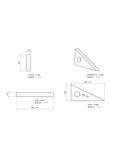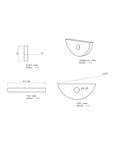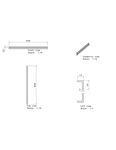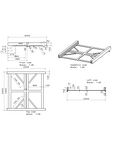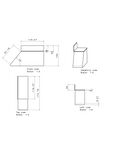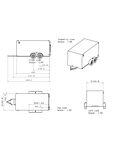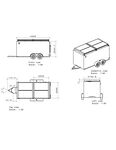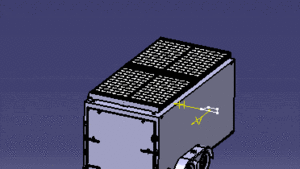
This a brief summary of Seyyed Ali Sadat's Bachelor of Science Project which is "Mega Energy Storage for Developing World: Analysis and Design"
For more information please check here
Abstract[edit | edit source]
The crisis can be described as a problematic era in one's life, initiated as a result of some critical events. Countries struggling with other problems such as economic shortage or poverty could be affected badly by these natural disasters. Crisis management has been long received much attention among practitioners, especially in developing countries where infrastructure is vulnerable. In this study, using the state of art knowledge, that is the solar energy, as well as some other sciences; we proposed a cost-effective and efficient way to design a valuable device for a vulnerable community aiming to address solutions alleviating the sophisticated conditions and suggesting implications regarding crisis control and management. The solar trailer is considered one of the ways to use and exploit renewable energies in crisis circumstances. In this thesis, the design for a solar trailer is discussed in detail. Indeed, the energy is stored in a solar trailer employing some solar photovoltaic cells, which can then be exploited to supply the required power to be used in providing medicines, sanitary water, and connecting to the network in the interested zone. Employing HOMER ® and PVsyst ® software, the optimal System has been obtained. Once the optimized System was obtained in HOMER and simulated in PVsyst, the interested solar trailer was designed in CATIA ® and prepared for production. The solar trailer in this study incorporates one refrigerator, a water treatment device, 8 solar panels of 400 W type, 12 batteries, a 4-kW generator, etc. Finally, the aforementioned solar trailer has been created using a 3D printer.
Project goals[edit | edit source]
- The power can be stored so that it can be used in emergencies, in a portable manner.
- Each moment of a crisis such as an earthquake is rife with ample financial, life, and psychological losses. The project findings can be employed to alleviate the crisis consequences.
- In the case of a crisis, using solar trailers can reduce costs.
- The ability to supply power, meeting injuries, and customers' needs, such as refrigerators and water treatment devices are some of the benefits of the generated power using clean energies. In such a case, the generated power is always available, so that there can be seen no disruption due to natural disasters.
- The possibility to transfer the generated power from solar energy to any arbitrary place.
- The nomad and refugee communities are considered as one the most vulnerable and the least prosperous population in the world. Meet their basic needs, as well as effective decision-making based on appropriate information to mitigate the shortages, has been long received much attention among practitioners. Nomadic society is a different way of life that is separate from the urban and rural life. It is a relatively self-sufficient human society with a tribal social structure, and they generally manage their lives from livestock. As the seasons change, nomads usually change their habitat to find suitable pastures for their animals; hence they always live in the mountains and plains. Electricity and refrigerators are among the necessities of modern life, but access to these facilities in these areas has always been difficult. Therefore, solar trailers can be considered an attractive choice for this segment of society.
Methodology to reach optimized design[edit | edit source]
In this research, the solar trailer system was designed based on HOMER PRO ® results. Then, the designed system was constructed and investigated using PVSYST ®. CATIA ® (CATIA v5 r27) has been used for the mechanical design of the device. The CAD design of this project has been done based on HOMER® optimization results finalized in PVsyst®. The optimized design, elegance, and meeting all the technical and engineering implications constitute some of the design characteristics of this product.
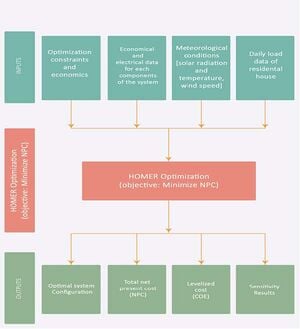
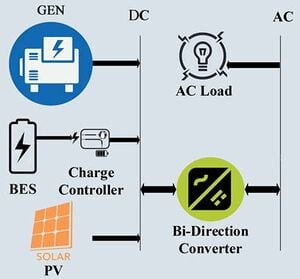
Constructing the prototype with a 3D printer[edit | edit source]
Following the analysis, optimization, modeling, and designing the solar trailer, the device has been constructed by the author with a 3D printer. Appropriate understanding of a 3D printer's advantages helps designers to make better decisions regarding the process selection and to supply a more optimized product.
Design[edit | edit source]
Discussion[edit | edit source]
The designed and constructed solar trailer applications are as follows:
- Transferring the power, medicines, and the treated water to the affected areas, and holistically, using the science and knowledge to scientifically manage crisis;
- It is useful for camping and off-road applications, and any other cases where the power is not available;
- The ability to supply power for certain places;
- Supplying power for events, such as circus, showrooms, and popup shopping centers that are temporarily set up in certain places, and have no cheap and easy access to power;
- Applicable for tourist camps and sites having no access to cheap power;
- Agricultural applications, such as water pumps;
- Supplying power for telecommunications; and
- Lighting applications.
Among various benefits of the constructed solar trailer in this project, one can name some as follows:
- The safe, robust, and reliable design;
- Ease of launching;
- Ease of towing;
- The cheap and portable electrical power;
- Crisis control and management by transferring power, medicines, and treated water;
- No urban and standard environment requirements to use the trailer;
- The capability to apply the desired changes; and
- There is no need to adjust panels, like the ones used on the ceilings.
Conclusions[edit | edit source]
Humankind has consistently struggled with various disasters and suffered a lot of life and financial damages. These harmful effects could be more destructive in the developing world. Therefore, different societies have always sought and developed ways to control or minimize the consequences of unexpected incidents, and in other words, to manage the crises and accidents. In this way, crisis management is considered so important. One of the effective ways that help people to mitigate the consequences is emergency relief to supply medicine and power. In this project, we addressed the investigations and manufacturing of an efficient and cost-effective solar trailer with specific applications for vulnerable people. It is worth mentioning that this thesis would strongly help the vulnerable community in developing countries such as nomads and refugees, who have consistently struggled with the lack of their basic needs. Besides supplying the solar electrical power, the trailer can be employed for miscellaneous other applications such as maintaining medicines in the trailer refrigerator and supplying the treated drinking water. Optimization results of the trailer have been carried out in HOMER® and PVSYST®. In this research, once the optimal system has been achieved in HOMER and the final system simulated in PVSYST, the solar trailer is designed in CATIA® and prepared for manufacturing. In this thesis, the best 3D and 2D model is designed in CATIA that includes eight solar panels of 400W type, 12 batteries, a 4-kW generator, etc. We used expert points of view to design the model, and since it has designed in HOMER, it is optimized. The simulation findings indicate the high accuracy of the research. Finally, the mentioned solar trailer was constructed by a 3D printer. As well, some of the research advantages are as follows:
- In emergencies, power can be stored. The energy will be portable.
- Each moment of crisis, like earthquakes, is rife with ample financial, life, and physiological losses. The project findings can be employed to alleviate the crisis consequences.
- In the case of a crisis, using the solar trailer can reduce expenses.
- The ability to supply power, meeting injuries, and customers' needs, such as refrigerators and water treatment devices, are some of the benefits of the generated power using clean energies. In such a case, the generated power is always available, so that there can be seen no disruption due to natural disasters.
- The generated power from solar energy can always be transferred to any arbitrary place.
- Solar trailers can help the nomads to provide the required electricity and cooling load.[1]
References[edit | edit source]
- ↑ Sadat, Seyyed. (2019). Mega Energy Storage for Developing World Analysis and Design. 10.13140/RG.2.2.18257.86883.
Contact details[edit | edit source]
For further inquires please contact seyyedalisadat1997@grad.kashanu.ac.ir or sasadat@ieee.org



